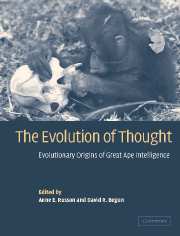Book contents
- Frontmatter
- Contents
- List of Contributors
- Preface
- 1 Evolutionary reconstructions of great ape intelligence
- 2 Enhanced cognitive capacity as a contingent fact of hominid phylogeny
- PART I COGNITION IN LIVING GREAT APES
- PART II MODERN GREAT APE ADAPTATION
- Introduction
- 7 What's in a brain? The question of a distinctive brain anatomy in great apes
- 8 Life histories and the evolution of large brain size in great apes
- 9 Evolution of complex feeding techniques in primates: is this the origin of great ape intelligence?
- 10 The special demands of great ape locomotion and posture
- 11 Great ape social systems
- 12 Diet and foraging of the great apes: ecological constraints on their social organizations and implications for their divergence
- PART III FOSSIL GREAT APE ADAPTATIONS
- Part IV INTEGRATION
- Author index
- Species index
- Subject index
12 - Diet and foraging of the great apes: ecological constraints on their social organizations and implications for their divergence
Published online by Cambridge University Press: 20 August 2009
- Frontmatter
- Contents
- List of Contributors
- Preface
- 1 Evolutionary reconstructions of great ape intelligence
- 2 Enhanced cognitive capacity as a contingent fact of hominid phylogeny
- PART I COGNITION IN LIVING GREAT APES
- PART II MODERN GREAT APE ADAPTATION
- Introduction
- 7 What's in a brain? The question of a distinctive brain anatomy in great apes
- 8 Life histories and the evolution of large brain size in great apes
- 9 Evolution of complex feeding techniques in primates: is this the origin of great ape intelligence?
- 10 The special demands of great ape locomotion and posture
- 11 Great ape social systems
- 12 Diet and foraging of the great apes: ecological constraints on their social organizations and implications for their divergence
- PART III FOSSIL GREAT APE ADAPTATIONS
- Part IV INTEGRATION
- Author index
- Species index
- Subject index
Summary
INTRODUCTION
Unlike the majority of the larger mammals, which are terrestrial herbivores, omnivores, or insectivores, nonhuman primates have created unique niches as arboreal insectivores, frugivores, or folivores. Primates now play important roles as fruit consumers and seed dispersers in tropical forests (Gautier–Hion et al. 1985; Terborgh 1986). However, food is still the primary limiting factor of primate populations because of its sparse distribution, physical protection (hard shells, spines, etc.), and toxic secondary compounds (Feeny 1976; Freeland & Janzen 1974; Milton 1984). Primates have evolved different strategies to cope with these dietary difficulties, and their specializations have influenced both anatomy and behavior.
Primates have evolved various features of gastrointestinal anatomy and the digestive system to cope with such dietary constraints. Leaves in particular are high in structural carbohydrates and are difficult to digest. Folivorous primates need more time to digest and absorb important food components to satisfy nutritional requirements. Specialization in gut morphology has raised the capacity of some primates to consume structural carbohydrates and detoxify secondary compounds (Kay & Davies 1994; Milton 1986). For example, the Colobinae have evolved a sacculated fermenting chamber in the stomach in which microbial fermentation precedes digestion and absorption (Bauchop & Martucci 1968; Chivers & Hladik 1980). Some secondary compounds are degraded during fermentation in the alkaline stomach environment before absorption. As an alternative strategy, a number of more folivorous primates, including howler monkeys, gorillas, bamboo lemurs, and sportive lemurs, have evolved an enlarged caecum or colon in which bacterial fermentation is activated (Stevens & Hume 1995).
- Type
- Chapter
- Information
- The Evolution of ThoughtEvolutionary Origins of Great Ape Intelligence, pp. 210 - 234Publisher: Cambridge University PressPrint publication year: 2004
- 19
- Cited by



